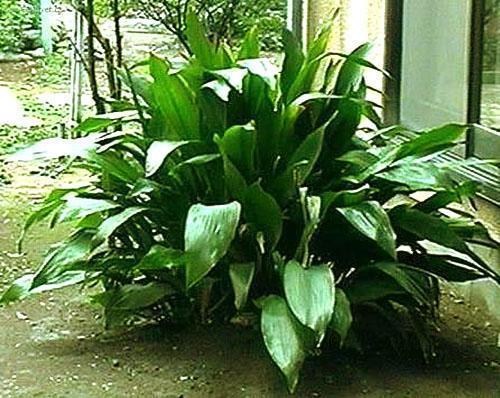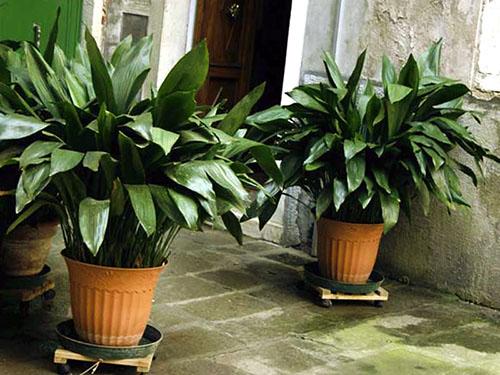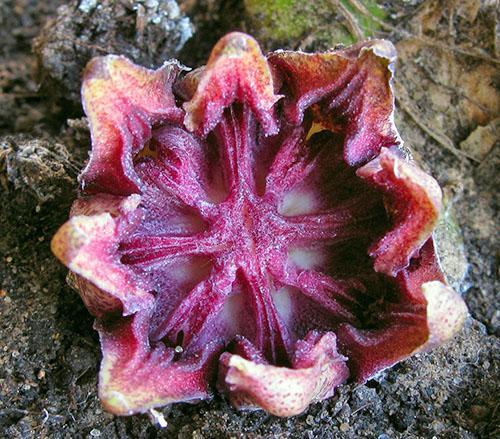Home care for aspidistra
 The role of green friends in the room is great, where a person spends most of the time. It has long been known that when we ventilate furniture, we throw a cocktail of industrial emissions through the window. We are reassured that pollution is normal. But few people know, only 20 compounds are determined in the laboratory, the rest are poisoned in silence, they are not registered. In these conditions, large-leaved ornamental plants will help out, which absorb all impurities and purify the air. The most unpretentious of them is aspidistra, caring for her at home will not cause difficulties.
The role of green friends in the room is great, where a person spends most of the time. It has long been known that when we ventilate furniture, we throw a cocktail of industrial emissions through the window. We are reassured that pollution is normal. But few people know, only 20 compounds are determined in the laboratory, the rest are poisoned in silence, they are not registered. In these conditions, large-leaved ornamental plants will help out, which absorb all impurities and purify the air. The most unpretentious of them is aspidistra, caring for her at home will not cause difficulties.
Requirements of the graduate student

 It is important to note that the plant is loved by flower growers and has received many popular names - mother-in-law's language, friendly family. Leaves from the rhizome emerge from the ground. This plant does not have a stem. With proper care, aspidistra blooms, which is clearly visible in the photo. In sparse gratitude, a flower will be released that lives only a day. Only by looking closely, it will turn out to see among the leaves, near the ground, a flower emerging from the root, which can be pollinated with similar ones and get one seed.
It is important to note that the plant is loved by flower growers and has received many popular names - mother-in-law's language, friendly family. Leaves from the rhizome emerge from the ground. This plant does not have a stem. With proper care, aspidistra blooms, which is clearly visible in the photo. In sparse gratitude, a flower will be released that lives only a day. Only by looking closely, it will turn out to see among the leaves, near the ground, a flower emerging from the root, which can be pollinated with similar ones and get one seed.
 An unpretentious plant tolerates all changes in the room's microclimate. It is afraid only of direct sunlight, excessive watering and complete drying out of the earth. It tolerates even a short-term drop in temperature, but not below the freezing point of water. The green mass grows slowly, 5-6 leaves per year. The root system grows and gives life to new stems.
An unpretentious plant tolerates all changes in the room's microclimate. It is afraid only of direct sunlight, excessive watering and complete drying out of the earth. It tolerates even a short-term drop in temperature, but not below the freezing point of water. The green mass grows slowly, 5-6 leaves per year. The root system grows and gives life to new stems.
Proper care for apidistra at home
 If your windows face the north side, they are blocked from the sun by a high-rise building or a balcony on the upper floor, aspidistra will be an ideal plant that will create a green corner. It is unpretentious in maintenance and is better than others for the first experiments in creating a home garden.
If your windows face the north side, they are blocked from the sun by a high-rise building or a balcony on the upper floor, aspidistra will be an ideal plant that will create a green corner. It is unpretentious in maintenance and is better than others for the first experiments in creating a home garden.
Like any plant, apidistra has features of care. The requirements are reduced to the creation of conditions for existence, providing:
- external factors of content;
- the composition of the soil and the timing of its replacement;
- watering and fertilizer;
- pests and diseases.
The determining factor is the shade tolerance of aspidistra. The plant feels great in partial shade and in diffuse lighting. If the leaf blade begins to fade, then the lighting should be slightly increased. There are variegated aspidistras, which, under diffused light, increase the contrast of the stripes, they become more elegant. Dots appearing on the leaves indicate sunburn.
 In the shade of aspidistra in the summer, it lives well in the fresh air, in the country, on the balcony. In this case, a small cover should be created from the scalding rays of the sun. It is not affected by night and daytime temperature drops. However, the plant develops comfortably at an average of 22 0... In the heat, the leaves dry out, the roots do not have time to water them.
In the shade of aspidistra in the summer, it lives well in the fresh air, in the country, on the balcony. In this case, a small cover should be created from the scalding rays of the sun. It is not affected by night and daytime temperature drops. However, the plant develops comfortably at an average of 22 0... In the heat, the leaves dry out, the roots do not have time to water them.
Winter content of plants in cool conditions, about 10 0 gives an acceleration in the growth of young greenery in the spring. But it is difficult to create such conditions in home conditions, however, 15 degrees can be provided. Accordingly, in winter the watering, the plant is not fertilized and does not increase moisture by spraying.
 The flower does not require frequent moistening of the leaves, but is grateful for the shower, wiping the leaves from dust. It must be remembered that aspidastra loves frequent moderate watering with settled soft water. Moisturizing a lump of earth should be 2-3 times a week in summer, in winter half as often.
The flower does not require frequent moistening of the leaves, but is grateful for the shower, wiping the leaves from dust. It must be remembered that aspidastra loves frequent moderate watering with settled soft water. Moisturizing a lump of earth should be 2-3 times a week in summer, in winter half as often.
The golden rule of flower growers for all plants must be observed. For all greenhouse and indoor plants, underfilling is not as bad as excessive moisture. Fertilizer is applied only to a moist clod of earth.
As for fertilizers, the flower is almost an ascetic. Frequent feeding is harmful to him. For variegated breeds, overfeeding can cause the disc to turn green. On the other hand, the richness of greens also depends on adequate nutrition. How to fertilize aspidistra and how often, are selected empirically, depending on the composition of the soil, the timing of the last transplant.
It is recommended to use liquid fertilizer "Uniflor", which is produced for growth, for green leaves, variegated species. The frequency of application is from 2 weeks to a month during the growing season. But if cracking of the leaves is suddenly noticed, this is overfeeding. Then stop fertilizing watering until the beauty of the leaves is restored.
An unpretentious plant does not require a special composition of the earth. For him, the soil that is prepared for seedlings of garden crops is enough:
- sod land - 2 parts;
- peat - 1 part;
- humus - 1 part;
- sand - 1 part; sheet land - 1 part.
 As always, the addition of vermiculite and crushed charcoal is encouraged. Aspidistra will develop in regular garden soil or purchased universal soil. plant transplant is carried out every 3 years. But the root grows quickly, so each transplant requires a 2-fold increase in the volume of land. Old plants are not transplanted, but they change the ground from above. The root system does not like shocks - this is the peculiarity of the aspidistra. The optimal method of transplanting is transshipment without destroying the clod of earth. The pot should allow the leaves to grow in breadth. At the same time, the plant needs a sufficient drainage layer.
As always, the addition of vermiculite and crushed charcoal is encouraged. Aspidistra will develop in regular garden soil or purchased universal soil. plant transplant is carried out every 3 years. But the root grows quickly, so each transplant requires a 2-fold increase in the volume of land. Old plants are not transplanted, but they change the ground from above. The root system does not like shocks - this is the peculiarity of the aspidistra. The optimal method of transplanting is transshipment without destroying the clod of earth. The pot should allow the leaves to grow in breadth. At the same time, the plant needs a sufficient drainage layer.
 Reproduction of aspidistra is carried out by dividing the bush during transplantation. In this case, you need to perform the operation in the least traumatic way. If you pinch off a root with 4-5 leaves, then the main bush will take it painlessly.
Reproduction of aspidistra is carried out by dividing the bush during transplantation. In this case, you need to perform the operation in the least traumatic way. If you pinch off a root with 4-5 leaves, then the main bush will take it painlessly.
Reproduction is carried out by dividing the leaf blade into fragments using a knife. Sections are dried. The resulting pieces are dipped in an airtight container with water. It can be a vessel with a wide mouth. In this case, complete tightness is achieved. The lid is poured with paraffin, covered with plasticine.
 Roots should appear on the edges. Then the seedling is placed in the ground and covered with a glass jar on top. When the aspidistra takes root, young leaves will appear, which need to be looked after as well as adult plants.
Roots should appear on the edges. Then the seedling is placed in the ground and covered with a glass jar on top. When the aspidistra takes root, young leaves will appear, which need to be looked after as well as adult plants.
Signs of insufficient care for aspidistra
A plant in captivity, even the most unpretentious, requires care. When leaving, you should take a closer look at the flower, and he himself will tell about the problems:
- slow growth - feed with urea;
- dark spots - examine for pests, remove from drafts, increase the temperature;
- dry tips of leaves - dry air, dry earth;
- sluggish blackening leaves - the plant was flooded;
- the leaves turn yellow - the plant is old or rotting of the roots.
 Like all other household inhabitants, the aspidastra, with improper care, is susceptible to colonization of spider mites, aphids and scale insects. You can deal with these pests with the help of chemicals, but you need to remember about protective measures for yourself and others.
Like all other household inhabitants, the aspidastra, with improper care, is susceptible to colonization of spider mites, aphids and scale insects. You can deal with these pests with the help of chemicals, but you need to remember about protective measures for yourself and others.